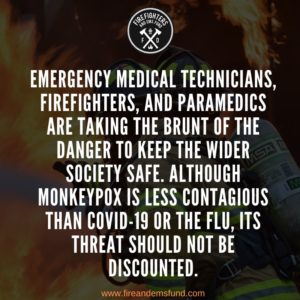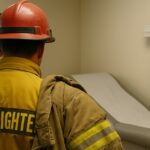Although not a new disease, the current levels of monkeypox spread are undoubtedly unprecedented. This is a rare contagious illness that, while rarely fatal, can result in hospitalizations and excruciating blisters around the body. Its transmission is far from the COVID-19 whirlwind of two years ago, which has helped monkeypox transmission fall under the radar in large parts of the country.
But while regular Americans may feel monkeypox remains remote, first responders are already exposed to it. What degree of risk are we facing? And what are emergency departments doing to protect us?
About the Current Monkeypox Outbreak
Until very recently, monkeypox was confined to Central and Western Africa. Throughout 2022, the disease began popping up across Western Europe, and in May 2022, the United States got its first confirmed case.
Ever since several clusters of cases have been identified around the country. To further muddle the issue, federal health officials recently confirmed the presence of two different variants circulating around the country.
Why is Monkeypox a Threat for First Responders?
Emergency medical technicians, firefighters, and paramedics are taking the brunt of the danger to keep the wider society safe. Although monkeypox is less contagious than COVID-19 or the flu, its threat should not be discounted.
Here are four factors that could place EMS workers at risk.
Low case counts

The first one may seem counterintuitive: usually, fewer cases mean less risk. But right now, monkeypox is in that uncomfortable middle ground where it’s not enough of a threat to the broader population, so it is not seen as deserving of strict isolation or additional PPE.
Granted, numbers in states like Florida or Oregon are now high enough to warrant special protocols. But in parts of the country where it remains scarce or still unseen, operators and healthcare providers are not even looking for it. As a result, an Emergency Medical Technician may receive no warning that they’re about to deal with a suspected case.
Transmission requires close contact with bodily fluids
Monkeypox is unlikely to be passed on at the supermarket line. Instead of a simple sneeze, it requires you to come into close contact with an infected person’s bodily fluids.
But for first responders, contact with blood, sweat, and urine is part of the routine. In high-stress, dangerous environments – such as fires, car crashes, and street fights – we routinely jump into the action, manipulating clothes and linens to ensure our patients’ survival.
Scarce vaccines
Many cities have begun mass vaccination drives for vulnerable populations. However, across most of the country, monkeypox vaccines remain scarce. Workers who wish to take that extra step for their personal safety still need to face long lines and red tape.
Easy-to-miss early symptoms
Most of us have seen the pictures of monkeypox’s characteristic rash. But before this rash develops, the early symptoms of monkeypox remain non-specific.
Suppose a patient presents with a standard fever, fatigue, or muscle aches, and later turns out to have monkeypox. In that case, the doctors and nurses who treated them at the hospital will most certainly be monitored. On the other hand, the ambulance technicians who drove them to the hospital can easily be missed.
The Bottom Line: Advocating for EMS Safety
Hopefully, the threat of monkeypox will subside quickly enough. Despite the initial hiccups in deploying them, we have a vaccine and several drugs available to treat it. Yet, EMS workers must remain vigilant when transporting or assessing patients, even if they appear healthy. It is also never too early to start demanding adequate PPE supplies and thorough guidelines to deal with accidental exposure.
Image Credit: Photo by Jack Plant on Unsplash








